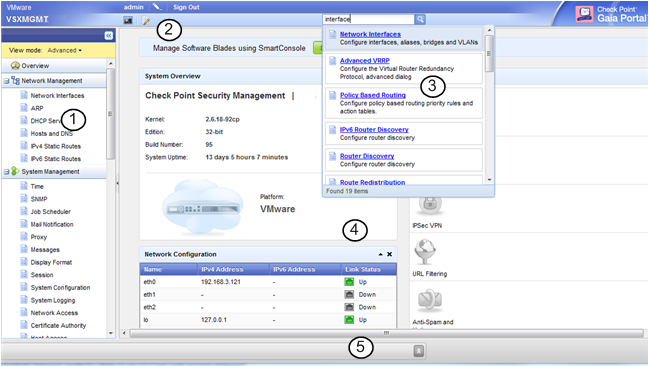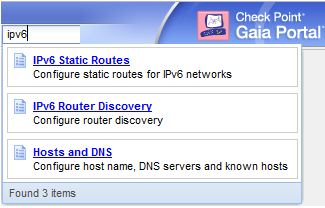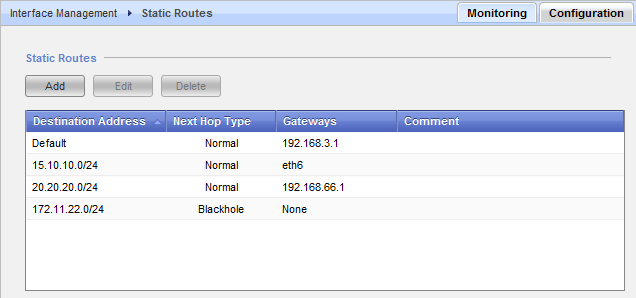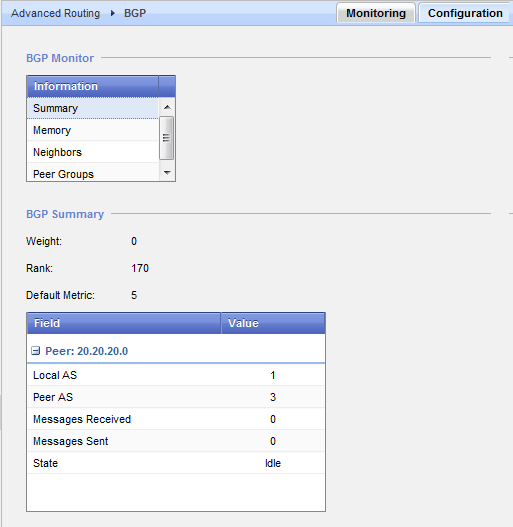Introduction to the WebUI
This chapter gives a brief overview of the WebUI interface and procedures for using the interface elements.
WebUI Overview
- The Gaia WebUI is an advanced, web-based interface for configuring Gaia platforms. Almost all system configuration tasks can be done through this Web-based interface.
- Easy Access - Simply go to https://<Device IP Address>.
- Browser Support - Internet Explorer, Firefox, Chrome and Safari.
- Powerful Search Engine - makes it easy to find features or functionality to configure.
- Easy Operation - Two operating modes. 1) Simplified mode shows only basic configuration options. 2) Advanced mode shows all configuration options. You can easily change modes.
- Web-Based Access to Command Line - Clientless access to the Gaia CLI directly from your browser.
The WebUI interface

|
|
|
|
Item
|
Description
|
1
|
Navigation tree
|
2
|
Toolbar
|
3
|
Search tool
|
4
|
Overview page with widgets that show system information
|
5
|
Status bar
|

|
Note - The browser Back button is not supported. Do not use it.
|
Logging in to the WebUI
Logging in
To log in to the WebUI:
- Enter this URL in your browser:
https://<Gaia IP address>
- Enter your user name and password.
Logging out
Make sure that you always log out from the WebUI before you close the browser. This is because the configuration lock stays in effect even when you close the browser or terminal window. The lock remains in effect until a different user removes the lock or the defined inactivity time-out period (default = 10 minutes) expires.
Working with the Configuration Lock
Only one user can have Read/Write access to Gaia configuration settings at a time. All other users can log in with Read-Only access to see configuration settings, as specified by their assigned roles.
When you log in and no other user has Read/Write access, you get an exclusive configuration lock with Read/Write access. If a different user already has the configuration lock, you have the option to override their lock. If you:
- Override the lock, the other user stays logged in with Read-Only access.
- Do not override the lock, you cannot modify the settings.
To override a configuration lock using the WebUI:
- Click the small lock icon
 (Configuration lock) above the toolbar. The pencil icon (Configuration lock) above the toolbar. The pencil icon  (Read/Write enabled) replaces the lock. (Read/Write enabled) replaces the lock.or
- If you are already using a configuration settings page, click the link. This can occur if a different user overrides your configuration lock.

|
Note - Only users with Read/Write access privileges can override a configuration lock.
|
Using the Interface Elements
The Gaia WebUI contains many elements that make the task of configuring features and system settings easier.
Toolbar Accessories
You can use these toolbar icons to do these tasks:
Item
|
Description
|

|
Read/Write mode enabled.
|

|
Configuration locked (Read Only mode).
|

|
Opens the accessory for CLI commands. Available in the Read/Write mode only.
|

|
Opens the accessory for writing notes or for quick copy/paste operations. Available in the Read/Write mode only.
|
Search Tool
You can use the search bar to find an applicable configuration page by entering a keyword. The keyword can be a feature, a configuration parameter or a word that is related to a configuration page.
The search shows a list of pages related to the entered keyword. To go to a page, click a link in the list.

Navigation Tree
The navigation lets you select a page. Pages are arranged in logical feature groups. You can show the navigation tree in one of these view modes:
- - Shows some standard pages
- (Default)- Shows all pages
To change the navigation tree mode, click and select a mode from the list.
To hide the navigation tree, click the  icon. icon.
Status Bar
The status bar, located at the bottom of the window, shows the result of the last configuration operation. To see a history of the configuration operations during the current session, click the  icon. icon.
Configuration Tab
The configuration tab lets you see and configure parameters for Gaia features and settings groups. The parameters are organized into functional settings groups in the navigation tree. You must have Read/Write permissions for a settings group to configure its parameters.

Monitoring Tab
The tab lets you see status and detailed operational statistics, in real time, for some routing and high availability settings groups. This information is useful for monitoring dynamic routing and VRRP cluster performance.
To see the tab, select a routing or high availability feature settings group and then click the tab. For some settings groups, you can select different types of information from a menu.

|



